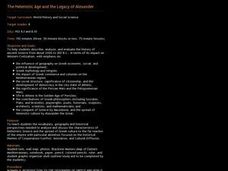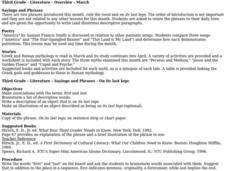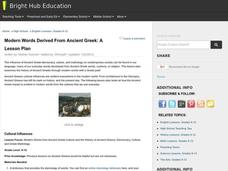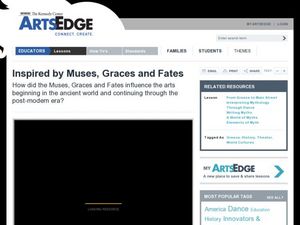Curated OER
Goddesses Are Personifications Too!
Students discover the use of personification as a way of expressing ideals. In this Language Arts activity, students create an allegorical depiction of a contemporary ideal. Students write labels that clearly support the...
Curated OER
Norse Mythology
Third graders read several selections of Norse mythology and compare this mythology to others studied in the past. They are introduced to runes. They read poetry and compile a class book of favorite poems. They define idioms and cite...
Curated OER
The Seven Wonders of the World: The Statue of Zeus at Olympia
Middle schoolers explore the culture of classical Greece by examining The Statue of Zeus at Olympia. In this Seven Wonders of the World lesson, students will expand their understanding of Greek mythology, the Olympics and the Greek...
Curated OER
J. Paul Getty Museum
Young scholars read mythological Greek and Roman stories. In this mythological lesson plan students read mythological stories about Greek and Roman times. As they read, they compare the written story to the visual art of the story.
Curated OER
Mythology in the ESL Classroom
Students study myths, mythological figures, and the ancient classics. They develop a sensitivity to the beliefs, values, attitudes, and views of man's development at that time. They illustrate the powers of each god discussed and...
Curated OER
Introducing Mythology
Students look closely at a poster of a Rembrandt painting and/or a transparency of a Greek vase, both of which represent the mythological story of the abduction of Europa. Studnets consider how two artists interpreted the same subject in...
Curated OER
Introducing the Olympian Gods
Young scholars compare and contrast characteristics of the Olympians with the character of the One True God. In this mythology instructional activity students work in groups and are assigned one god and one myth to compare and...
Curated OER
Those Fabulous Fables
A video leads off this activity on fables, introducing the class to this important form of traditional storytelling. The group defines fable and hears an explanation of the origin of this type of folk tale. They summarize the story they...
Curated OER
Dateline: 442 BC Antigone
Students create and videotape a newscast about the events that take place in the play, Antigone. They perform scenes describing the main events, the main characters and their conflicts.
Curated OER
Poseidon's Protectors to the Rescue
Students explore the concept of philanthropy. In this environmental stewardship lesson plan, students explore the Greek mythology story of Poseidon. Students write letters to Poseidon that address water pollution today and express how...
Curated OER
The Helenistic Age and the Legacy of Alexander
Eighth graders describe, analyze and evaluate the history of ancient Greece from 2000 to 300 B.C. They explore the influence of geography on Greek economical, social, and political development.
Curated OER
Vivid Verbs in Writing
Eighth graders explore how to incorporate vivid verbs in their writing. They review action verbs in sentences and view a Power Point presentation discussing possible verbs and their meanings. They view a website and retell a Greek myth...
Curated OER
Literature
Third graders study phrases, poetry and myths of Ancient Greece and Rome in these lessons.
Curated OER
Sparta and Athens
Sixth graders study Ancient Greece. For this Ancient Greece lesson, 6th graders complete 16 lessons to learn about Ancient Greece. Students complete a quiz for assessment.
Curated OER
Ancient Greece
Students explore the origins of modern language. In this etymology lesson, students discuss the cultural influences of Ancient Greece on modern society. Students design and complete charts that demonstrate the original and contemporary...
Curated OER
Getting the Story
Students examine and discuss the basic elements of a newspaper article. They listen to articles, discuss the 'inverted pyramid' style of a breaking news article, and list imaginary current events based on mythological characters.
Curated OER
Being in the Noh: An Introduction to Japanese Noh Plays
Learners read a Japanese Noh play and discuss its structure and traditional characters. They choose a short myth and write a Noh play based on it.
Curated OER
The Historical Development of Magnetism
Students discuss the history and importance of magnets to the world. In this magnetism lesson, students write an essay of a world without magnets. Students may research addition information to add details about uses of magnets.
Curated OER
Chile's Trapped Miners
Students read an article on trapped miners in Chile. In this social awareness ELL instructional activity, students read the details about how 33 miners had to be rescued in Chile when they got trapped underground. Activities that...
Curated OER
Inspired by Muses, Graces and Fates
Students examine how artists express the Muses through the arts. For this art and history lesson, students work cooperatively to identify the Greek Muses, Graces and the Fates. Students will identify the attributes of each, participate...
Newspaper in Education
The Iliad: A Young Reader Adventure
Is The Iliad part of your curriculum? Check out a resource that offers something for those new to teaching the classic and those with lots of experience using Homer's epic. Plot summaries, discussion questions, activities abound in...
Curated OER
Review of Ancient Greece
Students create Greek gifts out of paper as a review for an upcoming quiz. They are to use a manila envelope to create what they felt was an important gift the Greeks gave. Once the gift has been created, it is placed into a big bag...
Curated OER
Classical Mythological Monsters
Students, after researching and analyzing ancient Greek and Roman mythological monsters, create a monster of their own similar to one they've researched or studied in their class syllabus. In addition, they present their creations to the...
Curated OER
Mapping Constellations
Students become familiar with constellations. In this space science lesson, the teacher introduces constellations by showing students the star patterns and reading myths. Students, observe the stars nightly, then choose one constellation...

























